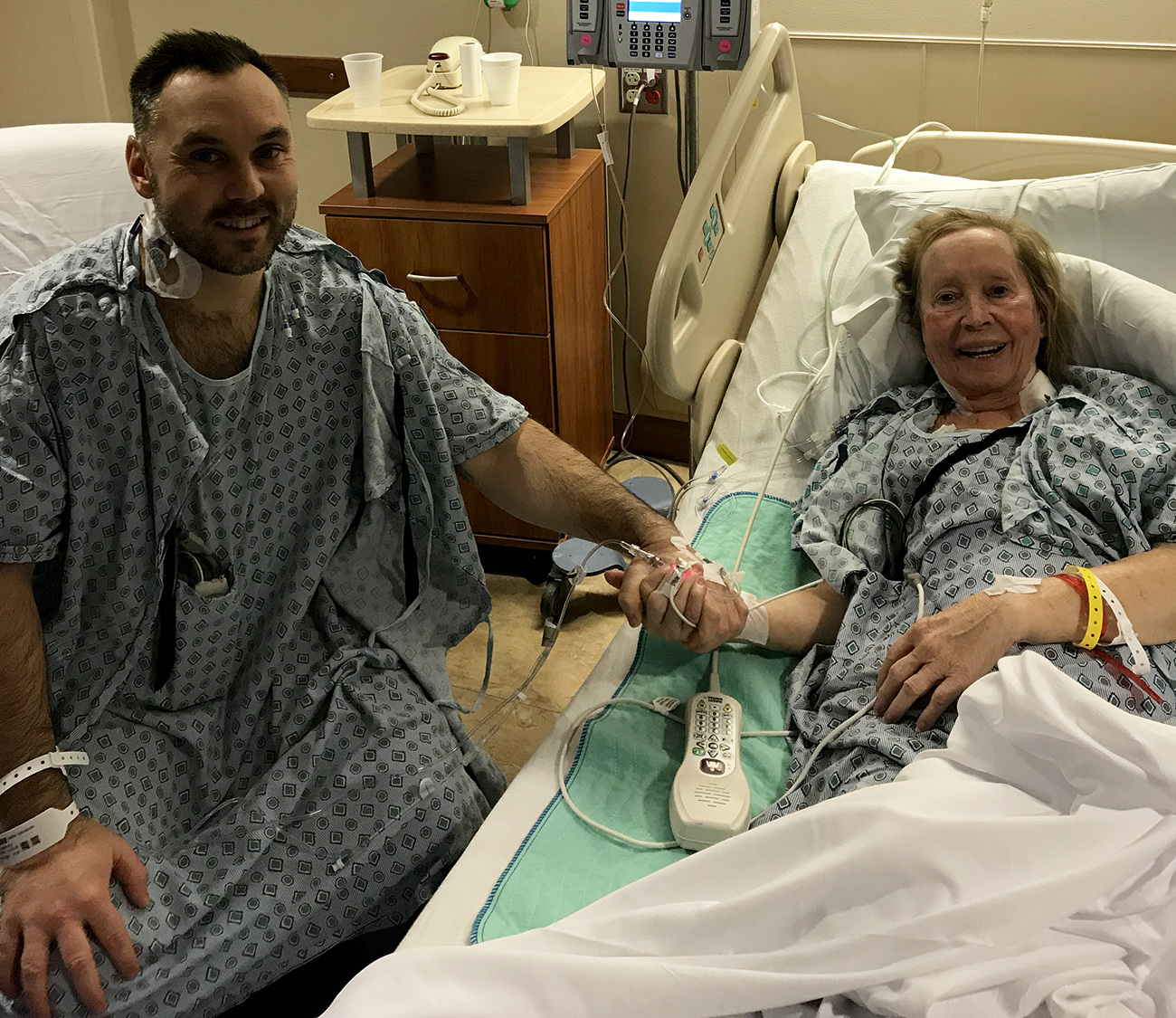How much money can I get for my liver donation?
May 31, 2017 · A living liver donation surgery involves removing part of a person’s healthy liver — as much as 60 percent — and using this partial liver to replace the recipient’s diseased liver. In the weeks to come, both the donor and recipient sections will grow to the size of normal livers.
What are the risks of donating your liver?
The offer to become a living liver donor is an amazing act of kindness. It's also a big commitment. At any point in the process, if you want to change your mind, you're allowed to do so.
What are the criteria for donating a liver?
In living liver donor surgery, the donor and the recipient are placed in side-by-side operating rooms. A surgeon removes a part of the donor’s liver, typically the right half. This donated segment of the liver is then immediately placed in the recipient in the next operating room.
Can I donate my liver and still live?
Dec 02, 2021 · Donate by Mail. If you prefer to make a donation by sending a check by mail you can do so here. Download this form and submit it with your check to…. Charitable Giving. American Liver Foundation. PO Box 299. West Orange, NJ 07052.

Does donating a liver shorten your life?
Whether you're giving away part of your liver or getting a new one, life often goes back to normal a few months after surgery. By the time you hit the 3-month mark, your liver will probably reach its normal size and you'll be back to your regular routine.Dec 3, 2019
What are the risks of donating part of your liver?
Risks Associated with Liver DonationPossible allergic reaction to anesthesia.Pain and discomfort.Nausea.Wound infection.Bleeding that may require transfusion.Blood clots.Pneumonia.Bile leakage, bile duct problems.More items...
How do you donate a liver while alive?
A living liver donation surgery involves removing part of a person's healthy liver — as much as 60 percent — and using this partial liver to replace the recipient's diseased liver. In the weeks to come, both the donor and recipient sections will grow to the size of normal livers.May 31, 2017
What qualifies you to be a liver donor?
Donors must have a compatible blood type and liver anatomy that is suitable for donation. Potential liver donors must not have any serious medical conditions, such as liver disease, diabetes, heart disease or cancer. To become a live liver donor, you must: Be a willing adult between age 18 and 60.
Can a female donate a liver to a male?
Overall, data collected from transplants performed around the world showed that gender didn't seem to matter. But when the authors isolated the data from North America, they found female-donated livers that were transplanted into male patients were less likely to succeed than male-donated livers.Nov 6, 2002
What disqualifies you from a liver transplant?
acute rejection. the return of liver disease. cancer. medical complications, such as high blood pressure, infection, diabetes, and high cholesterol.
Can O positive donate liver to anyone?
If you have Type O blood, you are a "universal donor" and can donate to anyone (although Type O liver recipients can only get organs from people who are also Type O).Sep 29, 2021
Do we have 2 livers?
The liver has two large sections, called the right and the left lobes. The gallbladder sits under the liver, along with parts of the pancreas and intestines. The liver and these organs work together to digest, absorb, and process food.Jun 23, 2021
Do you need a liver to live?
The liver performs essential, life-sustaining functions. While you can't live without a liver completely, you can live with only part of one. Many people can function well with just under half of their liver. Your liver can also grow back to full size within a matter of months.Nov 30, 2018
How long is the liver transplant waiting list?
The average waiting time for a liver transplant is 145 days for adults and 72 days for children. However, your waiting time may be a lot shorter if you are on a high-priority waiting list.Sep 24, 2021
Does insurance cover liver donation?
A: No – not to pay for costs of the donation, because the costs are billed to the health insurance of the recipient (person who receives the organ).
What is the age limit for liver transplant?
Liver transplantation from donors aged 80 years and over: pushing the limit. In the current context of organ shortage, the issue is not whether older donors should be used, rather how to use them and in which recipients.Dec 18, 2018
Surgery
In living liver donor surgery, the donor and the recipient are placed in side-by-side operating rooms. A surgeon removes a part of the donor’s liver, typically the right half. This donated segment of the liver is then immediately placed in the recipient in the next operating room.
Additional Resources
Click here to learn more about becoming a peer Mentor like Janet or to receive one-on-one support from a peer Mentor.
Getting Started
To be considered for live liver donation, fill out the form below. Please answer all questions truthfully and accurately. All information you share with our transplant team is strictly confidential.
More Information About Live Liver Donation
Comprehensive information about living donation is available through the United Network for Organ Sharing (UNOS).
Liver Donor Evaluation Form
In order to be considered as a live liver donor you must submit the electronic form. All information is confidential.
When is a liver donation needed?
A liver transplant is an option for people who have end-stage liver failure that cannot be controlled using other treatments, or for some people with specific types of liver cancer. Liver failure can be categorized as acute liver failure (occurring rapidly, in a matter of weeks) or chronic liver failure (occurring slowly over months and years).
Living Donor Liver Transplant
A small percentage of liver transplants are completed each year using a portion of a healthy liver from a living donor. Living donation is possible because the liver is the only organ that can regenerate itself. An adult may be able to donate a portion of their liver to a child or another adult.
Liver transplantation
Following a liver transplant, recipients may stay in the intensive care unit for a few days and spend 5-10 additional days in the hospital. Recovery time at home varies for each person, most recipients can resume simple activities of daily living within a week.
Can You Donate Your Liver If You're Still Alive?
To many people, the phrase "living liver donor" may sound frightening. But did you know living liver donation is safe? After donating part of your liver, your liver will regrow and work normally again within just a few months.
Facts About Living Liver Donation
Your liver is an incredible organ. It actually regrows to its original size within six months of a living liver donation surgery. Like any surgery, the procedure does have some risks. But overall, living liver donation is safe. Our team will always act in your best interests and safety as a donor.
Financial Resources
Are you considering living liver donation but are worried about how much it will cost? Learn more about financial resources by reading the American Society of Transplantation's Live Donor Financial Toolkit.
Hear From Our Patients
It’s been a long 36 years for Lynn Clark, 57, who has felt “rundown and exhausted” for much of his adulthood. The Hyrum man’s troubles began after a car accident in 1980 led him to receive a blood transfusion.
Hear From Our Specialists
Most parents have never thought about the difficult decision of whether or not you should donate your child’s organs when the unthinkable happens. Pediatrician Dr. Cindy Gellner discusses the potential benefits of pedi...
Evaluation for a Living Donor
The evaluation helps determine if you are an appropriate match with your recipient and if you are medically fit to donate. In the first stage of evaluation, you’ll undergo tissue typing and lab screening and complete a liver donor questionnaire .
Surgery and Recovery for a Living Donor
After a thorough evaluation, if you are approved for donation, surgery will be scheduled. Unless an urgent transplant is needed, surgery is usually scheduled four to six weeks in advance. Typically, a liver donor spends approximately seven days in the hospital, and will have an additional six to eight weeks of recovery time.
Risks Associated with Liver Donation
Even though live liver donation is considered a very safe operation, it involves major surgery and is associated with complications, which may include:
Overview
During living-donor liver donation, surgeons remove a portion of the donor liver and place it into the recipient.
Start Your Donor Evaluation
Begin the process of becoming a living kidney or liver donor by clicking here to complete a Health History Questionnaire.
What you can expect
To be considered for a living-donor liver transplant, both the donor and recipient must undergo a thorough health and psychological evaluation at a transplant center. Separate transplant teams will care for the donor and recipient during the evaluation process and will discuss the potential benefits and risks of the procedure in detail.
Pro: Livers grow back
If you're going to be a donor, you may worry that removing part of your liver will hurt your health. But you can lose up to 75% of it, and it will grow back to its original size quickly -- and work just fine when it does.
Con: You could have complications
"The donor can [get] medical complications such as bleeding, bile leaks, infections, or blood clots," Te says.
Pro: Transplants from living donors go more smoothly
Since livers from living donors are outside the body for a shorter amount of time than ones that come from someone who has died, they tend to "take" better, Te says.
Con: Recipients need meds for life
Whether your liver comes from a living donor or not, it will be a big boost to your health. But your new liver is also a stranger to your body. You'll have to take drugs that keep your immune system -- your body's defense against germs -- from treating the new liver as an invader that needs to be attacked.
Pro: You have more control over the process
Most living-donor transplants happen between family members or close friends. If you know someone who is willing and able to give you part of their liver, you may be able to get a transplant more quickly than you would if you have to wait until a liver becomes available from a donor who has died.
Con: You'll be sidelined after surgery
You may spend some time in an intensive care unit after you get your new liver, and up to 10 days in the hospital overall.
Pro: Donors are covered by insurance
Normally, the health insurance of the person who is getting a new liver covers the expense of the donor, including pre-transplant evaluations, surgery, in-hospital recovery, and follow-up care.

Popular Posts:
- 1. where can i donate a baby stroller near me
- 2. where can i donate my time on thanksgiving in nova
- 3. where to donate household items
- 4. how to donate car without title
- 5. where can you donate
- 6. where to donate towels and blankets
- 7. how much to donate plasma near me
- 8. where to donate trading cards
- 9. where to donate bikes in az
- 10. where to donate otasco stuff